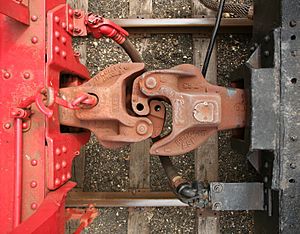Janney coupler facts for kids
Janney couplers are special connectors that link train cars together. They are also called knuckle couplers. These couplers are "semi-automatic," meaning they connect almost by themselves when two train cars gently bump into each other.
The first Janney coupler was invented by Eli H. Janney in 1873. Later, Andrew Jackson Beard and other inventors made many improvements to this design. Their work helped make train travel safer and more efficient.
In countries like the UK, different types of Janney couplers are used on some trains. These include passenger coaches, freight wagons, and locomotives.
Contents
How Janney Couplers Work
Janney couplers connect train cars securely. They have a part that looks like a hand or "knuckle" that locks into another coupler. This strong connection allows trains to pull heavy loads safely.
Different Types of Janney Couplers
There are several types of Janney couplers, each designed for specific train cars:
- Type E couplers are often used on freight wagons.
- Type F InterLock couplers are designed for heavy-duty freight cars.
- Type H TightLock couplers are used on passenger trains. They help keep the cars very close together, making the ride smoother. They also reduce the risk of cars "telescoping" (one car sliding into another) during an accident.
All these types are designed to work together, even if they look a bit different.
History and Standardization
In the early days, many different companies made their own types of couplers. This made it hard to connect train cars from different companies.
Early Coupler Designs
In the 1880s and 1890s, there were many different knuckle couplers. They all looked similar on the outside, so they could connect. However, their inside parts were often unique to each company. This meant repairs could be tricky.
Standardization by the AAR
To solve this problem, a group called the Master Car Builder (MCB) Association started to standardize couplers. This group later became the Association of American Railroads (AAR) in 1934.
In 1913, the "Type D" coupler became the standard for North America. This meant all new and rebuilt train cars had to use this design. This helped make train connections much easier and safer across the continent.
The "Alliance coupler" was developed as a lighter version of the "Type D." It is now one of the most common knuckle couplers used around the world.
Improving Coupler Shapes
The outside shape of Janney couplers was standardized first. Over the years, the shape was improved several times:
- In 1893, the MCB-5 or Type C shape became standard.
- In 1915, the improved MCB-10 or Type D shape was adopted.
- In 1932, the AAR-10A or Type E shape became the new standard.
Even with these changes, the newer couplers could still connect with older ones. Modern Janney couplers still use the 1932 shape. Better materials and manufacturing have made them even stronger and reduced "coupler slack." This means there is less jerky movement between cars.
Images for kids
-
"Drophead" coupler swung down reveals buffers and chain coupler on a British Rail Class 91.
-
AAR Type E coupler (left) c. 1932, MCB Type 5 coupler (right) required by 1893 Railroad Safety Appliance Act.
-
AAR Type H coupler on British Rail Class 321 with full auto power and control connections.















